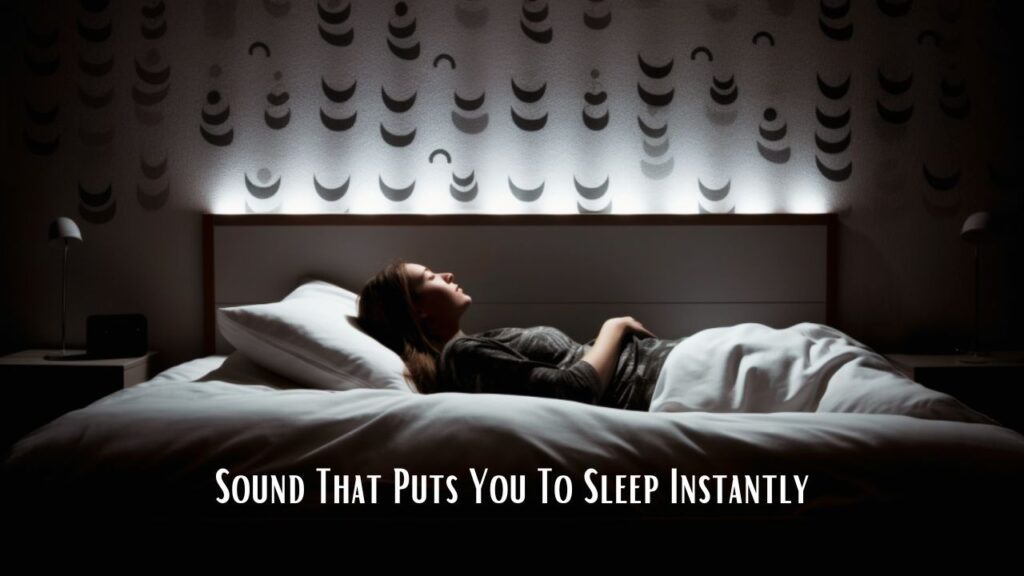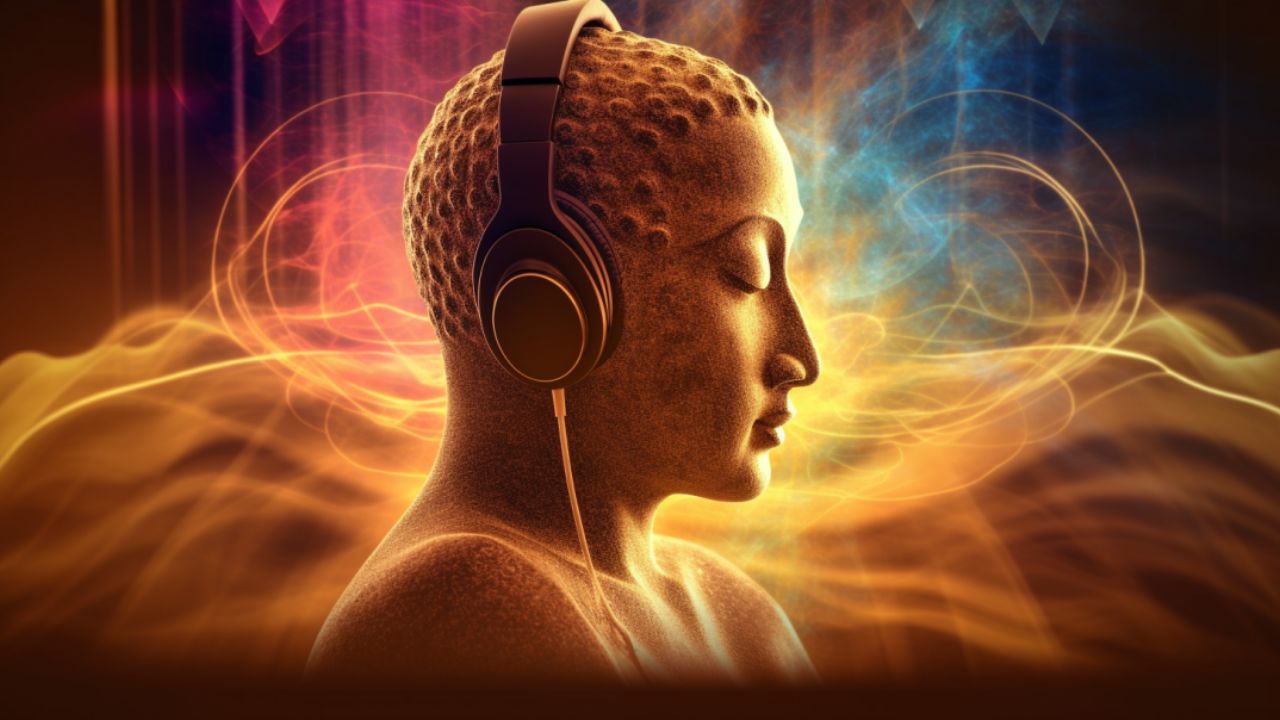
The importance of a good night’s sleep cannot be overstated. It’s when our body and mind can rest and recharge for the next day. However, for many people, falling asleep can be a struggle. Fortunately, there is a solution – the sound that puts you to sleep instantly.
This article will explore the science behind sound and sleep and share the best sounds to help you quickly fall asleep and wake up refreshed.
The Science Of Sound And Sleep
Before we dive into the different types of sounds that can help you fall asleep, let’s first understand the science behind sound and sleep.
Sound is a form of energy that travels through the air through sound waves. These sound waves can impact our bodies differently, including our sleep patterns.
Research has shown that sound can have a powerful effect on our sleep. Different types of sounds can either promote or disrupt sleep, depending on the frequency and volume of the sound.
For example, low-frequency sounds, such as waves crashing or a fan’s hum, can promote relaxation and improve sleep quality. In contrast, high-frequency sounds, such as loud music or traffic noise, can disrupt sleep and cause us to wake up feeling tired and groggy.
Now that we understand the science behind sound and sleep. Let’s dive into the different sounds that can help us fall asleep.
The Best Sounds To Help You Fall Asleep
1. White Noise
White noise is a type of sound that is produced by combining different sound frequencies at equal intensities. That results in a consistent sound that masks other sounds in the environment. “white noise” is derived from white light, comprising all the visible spectrum colours combined.
White noise can help promote relaxation and sleep by creating a constant, soothing background sound that masks other noises and distractions. It can benefit people living in noisy environments, such as cities or near busy roads, or those with trouble falling asleep due to anxiety or racing thoughts.
In addition to its sleep-promoting effects, white noise has also been shown to have other benefits. Research has found that it can improve cognitive function, enhance creativity, and even reduce tinnitus symptoms (ringing in the ears).
Various white noise machines, apps, and websites offering white noise tracks are available on the market. Some popular types of white noise include rain, waves, and the sound of a fan.
If you’re considering using white noise to help you sleep, finding a sound that works for you is essential. Experiment with different types of white noise and volume levels to see what benefits you relax and fall asleep more easily. Additionally, use the white noise machine or app responsibly by following the manufacturer’s instructions and not using it at loud volumes.
2. Pink Noise
Pink noise is a type of sound similar to white noise but with a different frequency spectrum. While white noise contains all frequencies at equal intensities, pink noise is louder at lower frequencies and softer at higher frequencies, resulting in a more balanced and natural sound.
Like white noise, pink noise can help promote relaxation and sleep. Studies have found that listening to pink noise can improve the quality of deep sleep, the most vital stage of the sleep cycle. Pink noise has also been shown to help regulate brain waves, leading to deeper, more restful sleep.
In addition to its sleep-promoting effects, pink noise has also been found to have other benefits. Research has shown that it can improve focus and concentration, enhance memory consolidation, and even reduce symptoms of dementia and Alzheimer’s disease.
Some popular types of pink noise include the sound of a heart beating, rainfall, and wind chimes. Like white noise, pink noise can be found on various sound machines, apps, and websites.
3. Nature Sounds
Nature sounds are a broad category of sounds typically associated with the natural world, such as sounds of animals, water, wind, and plants. These sounds have been found to have a calming and soothing effect on the mind and body and can be used to promote relaxation and sleep.
Nature sounds are often used in sound therapy, a holistic approach to health that uses sound to heal the body and mind. Sound therapy is based on the principle that everything in the universe vibrates at a particular frequency and that exposure to specific frequencies can have a therapeutic effect on the body.
Research has found that exposure to nature sounds can reduce stress and anxiety, lower blood pressure and heart rate, and improve overall well-being. Some popular nature sounds include birdsong, ocean waves, rainfall, and wind blowing through trees.
4. Binaural Beats
Binaural beats are a type of sound that can be used for relaxation, meditation, and sleep. They are created by playing two slightly different frequencies in each ear, which causes the brain to perceive a third frequency, which is the difference between them.
Research has shown that listening to binaural beats can have several benefits, such as reducing anxiety, improving mood, and enhancing cognitive performance. They can also help induce a meditative state and improve sleep quality.
Binaural beats can be found on various apps and websites and are often paired with relaxing music or nature sounds to enhance their effects. However, it’s important to note that binaural beats should not be used by people with certain medical conditions, such as epilepsy or heart disorders, without first consulting with a healthcare professional.
If you’re considering using binaural beats, it’s essential to use them responsibly and to find a frequency that works for you. It’s also necessary to use headphones, as the effect is achieved through the difference in frequencies played in each ear.
5. Instrumental Music
Instrumental music is music that is composed and performed without the use of vocals or lyrics. It is often used for relaxation, meditation, and background music for various activities, such as studying or working.
One of the main advantages of instrumental music is that it can be used in various settings and for multiple purposes. For example, soft and slow instrumental music can be used for relaxation and stress relief, while faster and more upbeat music can be used for motivation and energy.
If you’re considering using instrumental music for relaxation or other purposes, it’s essential to use it responsibly and to find a volume and genre that works for you. It’s also important to note that some types of instrumental music may not be suitable for certain activities, such as driving or operating heavy machinery.
6. Guided Meditation
Guided meditation is a type of meditation that is led by a teacher or a recording. It often involves visualizations and other techniques to help you relax and focus your attention.
During guided meditation, the teacher or recording may guide you through visualizations, such as imagining a peaceful setting or focusing on your breath. They may also use other techniques, such as progressive muscle relaxation or body scans, to help you release tension and become more aware of your physical sensations.
Research has shown that guided meditation can have several benefits, such as reducing stress and anxiety, improving mood, and enhancing cognitive performance. It can also be used to help improve sleep quality and reduce symptoms of depression.
Guided meditation can be found on various apps and websites and is often paired with soothing music or nature sounds to enhance its effects. It’s essential to find a type of guided meditation that works for you, as everyone has different preferences and sensitivities to guided meditation.
If you’re considering using a guided meditation for relaxation or other purposes, it’s essential to use it responsibly and to find a meditation that fits your needs and lifestyle. It’s also important to note that guided meditation should not be used as a substitute for professional medical advice or treatment.
In conclusion, finding the right sound that puts you to sleep instantly is an essential step toward achieving restful and rejuvenating sleep. Whether it’s the soothing sound of white noise or the calming effect of nature sounds, incorporating peaceful sounds into your bedtime routine can significantly impact your sleep quality and overall health.
Experimenting with different sounds and finding what works best for you is essential. Some people may find that listening to instrumental music is the key to falling asleep quickly, while others may prefer guided meditation or binaural beats. Whatever your preference, incorporating a sound that puts you to sleep instantly into your bedtime routine can help you achieve better sleep and wake up feeling refreshed and energized.
Remember, getting a good night’s sleep is essential for overall health and well-being. By prioritizing sleep and incorporating calming sounds into your bedtime routine, you can improve your sleep quality and wake up feeling ready to take on the day.
So if you’re struggling to fall asleep or stay asleep, consider trying different types of sounds to find the one that puts you to sleep instantly. You may be surprised at its positive impact on sleep and overall health.
Find a sound that puts you to sleep instantly:
– Drift Off To Sleep With Soothing Underwater Ambience Sounds | Submerge Into Serenity | 8 Hours
– Journey Through The Cosmos: Deep Space White Noise For Total Relaxation, Study Or Sleep
– Journey to Inner Peace: Soothing Meditative Ambient Music For Relaxation And Mindfulness
– Ultimate Deep Relaxing Music For Sleep And Meditation: Calm Your Mind And Drift Away
– Tired of tossing and turning all night? Let the power of sound help you drift off to sleep with ease. Discover the perfect sound that puts you to sleep instantly and experience the transformative benefits of a full night’s rest. Click here to get started now!

